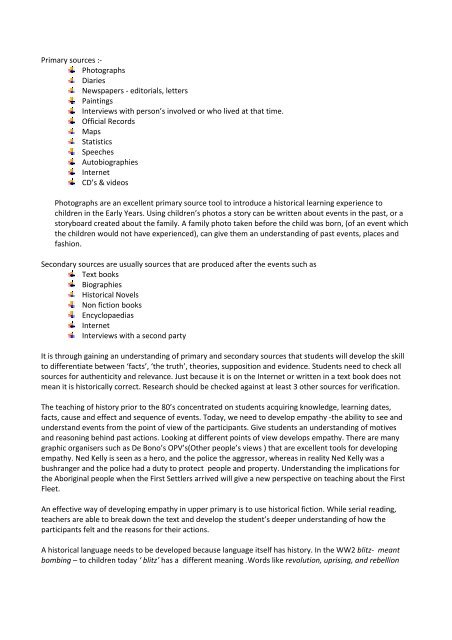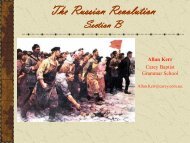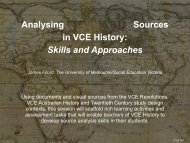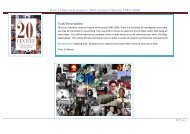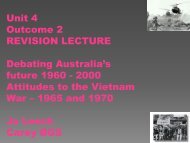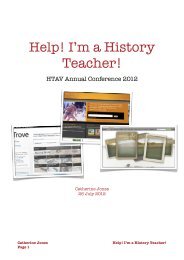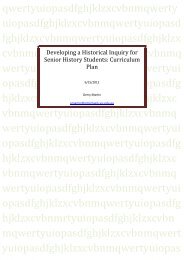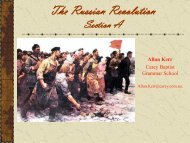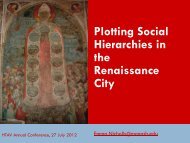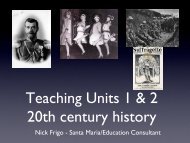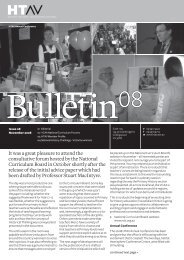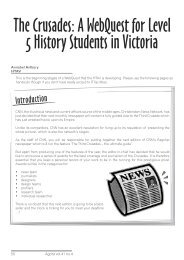Teaching history in the primary classroom, - HTAV
Teaching history in the primary classroom, - HTAV
Teaching history in the primary classroom, - HTAV
You also want an ePaper? Increase the reach of your titles
YUMPU automatically turns print PDFs into web optimized ePapers that Google loves.
Primary sources :‐<br />
Photographs<br />
Diaries<br />
Newspapers ‐ editorials, letters<br />
Pa<strong>in</strong>t<strong>in</strong>gs<br />
Interviews with person’s <strong>in</strong>volved or who lived at that time.<br />
Official Records<br />
Maps<br />
Statistics<br />
Speeches<br />
Autobiographies<br />
Internet<br />
CD’s & videos<br />
Photographs are an excellent <strong>primary</strong> source tool to <strong>in</strong>troduce a historical learn<strong>in</strong>g experience to<br />
children <strong>in</strong> <strong>the</strong> Early Years. Us<strong>in</strong>g children’s photos a story can be written about events <strong>in</strong> <strong>the</strong> past, or a<br />
storyboard created about <strong>the</strong> family. A family photo taken before <strong>the</strong> child was born, (of an event which<br />
<strong>the</strong> children would not have experienced), can give <strong>the</strong>m an understand<strong>in</strong>g of past events, places and<br />
fashion.<br />
Secondary sources are usually sources that are produced after <strong>the</strong> events such as<br />
Text books<br />
Biographies<br />
Historical Novels<br />
Non fiction books<br />
Encyclopaedias<br />
Internet<br />
Interviews with a second party<br />
It is through ga<strong>in</strong><strong>in</strong>g an understand<strong>in</strong>g of <strong>primary</strong> and secondary sources that students will develop <strong>the</strong> skill<br />
to differentiate between ‘facts’, ‘<strong>the</strong> truth’, <strong>the</strong>ories, supposition and evidence. Students need to check all<br />
sources for au<strong>the</strong>nticity and relevance. Just because it is on <strong>the</strong> Internet or written <strong>in</strong> a text book does not<br />
mean it is historically correct. Research should be checked aga<strong>in</strong>st at least 3 o<strong>the</strong>r sources for verification.<br />
The teach<strong>in</strong>g of <strong>history</strong> prior to <strong>the</strong> 80’s concentrated on students acquir<strong>in</strong>g knowledge, learn<strong>in</strong>g dates,<br />
facts, cause and effect and sequence of events. Today, we need to develop empathy ‐<strong>the</strong> ability to see and<br />
understand events from <strong>the</strong> po<strong>in</strong>t of view of <strong>the</strong> participants. Give students an understand<strong>in</strong>g of motives<br />
and reason<strong>in</strong>g beh<strong>in</strong>d past actions. Look<strong>in</strong>g at different po<strong>in</strong>ts of view develops empathy. There are many<br />
graphic organisers such as De Bono’s OPV’s(O<strong>the</strong>r people’s views ) that are excellent tools for develop<strong>in</strong>g<br />
empathy. Ned Kelly is seen as a hero, and <strong>the</strong> police <strong>the</strong> aggressor, whereas <strong>in</strong> reality Ned Kelly was a<br />
bushranger and <strong>the</strong> police had a duty to protect people and property. Understand<strong>in</strong>g <strong>the</strong> implications for<br />
<strong>the</strong> Aborig<strong>in</strong>al people when <strong>the</strong> First Settlers arrived will give a new perspective on teach<strong>in</strong>g about <strong>the</strong> First<br />
Fleet.<br />
An effective way of develop<strong>in</strong>g empathy <strong>in</strong> upper <strong>primary</strong> is to use historical fiction. While serial read<strong>in</strong>g,<br />
teachers are able to break down <strong>the</strong> text and develop <strong>the</strong> student’s deeper understand<strong>in</strong>g of how <strong>the</strong><br />
participants felt and <strong>the</strong> reasons for <strong>the</strong>ir actions.<br />
A historical language needs to be developed because language itself has <strong>history</strong>. In <strong>the</strong> WW2 blitz‐ meant<br />
bomb<strong>in</strong>g – to children today ‘ blitz’ has a different mean<strong>in</strong>g .Words like revolution, upris<strong>in</strong>g, and rebellion


